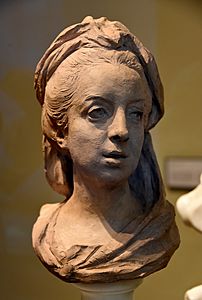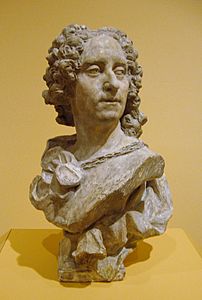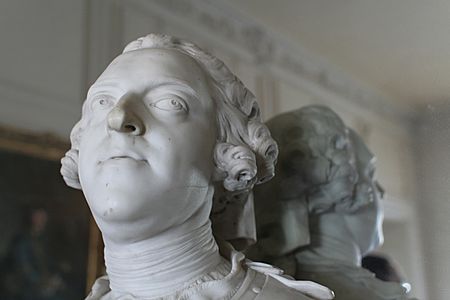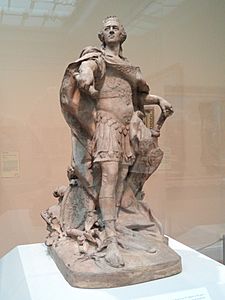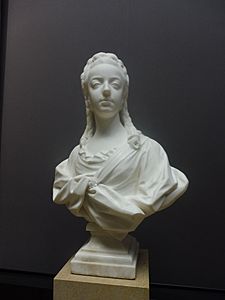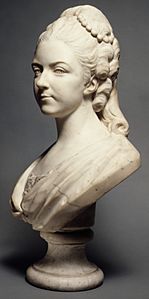Jean-Baptiste Lemoyne facts for kids
Quick facts for kids
Jean Baptiste Lemoyne
|
|
|---|---|

A portrait of Lemoyne by Jean Valade, found at the Palace of Versailles
|
|
| Born |
Jean Baptiste Lemoyne
15 February 1704 Paris, France
|
| Died | 27 July 1762 (aged 64) Paris, France
|
| Nationality | French |
| Known for | Sculpture |
|
Notable work
|
Fontaine des Quatre-Saisons |
Jean-Baptiste Lemoyne (born February 15, 1704 – died 1778) was a very talented French sculptor from the 1700s. He worked in two popular art styles: rococo and neoclassical.
He created huge statues for the beautiful Gardens of Versailles. But he was most famous for his amazing portrait busts. These were sculptures of people's heads and shoulders that looked very real and showed their feelings.
Contents
Becoming a Master Sculptor
Jean-Baptiste Lemoyne was born in Paris, France, in 1705. His father, Jean-Louis Lemoyne, was also a sculptor and taught him first. Later, he learned from another famous sculptor named Robert Le Lorrain.
Sometimes, people call him Jean-Baptiste II Lemoyne or "the younger." This helps tell him apart from his uncle, who had the same name and was also a sculptor.
He won a special award called the prix de Rome from the Royal Academy of Painting and Sculpture. But he stayed in Paris to help his father, who had become blind.
Lemoyne joined the Academy in 1738 and later became its director. Like other royal sculptors, he made many statues for the Gardens of Versailles.
Working for the King's Court
He was a special favorite of Madame de Pompadour. She was the mistress of King Louis XV and a very important supporter of the arts. Lemoyne made a graceful rococo sculpture of Vertumnus and Pomone for her. These are two characters from the ancient stories of Ovid. This story was one of Madame Pompadour's favorite themes. This sculpture is now in the Louvre Museum.
He also made a statue of Madame de Pompadour dressed as a nymph. Lemoyne created several sculptures of King Louis XV. One was a large statue of the King on horseback for the new Ecole Militaire. Sadly, this statue was destroyed during the French Revolution.
His Famous Portrait Busts
Lemoyne was especially known for his amazing portrait busts. These sculptures captured the small changes in people's expressions. They made the sculptures seem to move and feel alive.
Some of his important portrait busts include:
- The scientist René Antoine Ferchault de Réaumur (1751)
- The painter Noël-Nicolas Coypel (1760)
- The writer Fontenelle (at Versailles)
- Madame de Pompadour
- Marie-Antoinette (1771)
Many people think he was the most skilled French sculptor of the rococo period.
His Talented Students
Jean-Baptiste Lemoyne taught many students who became famous sculptors themselves. These included Étienne Maurice Falconet, Jean-Baptiste Pigalle, and Augustin Pajou.
Sculptures by Lemoyne
-
A sculpture of Louis XV from 1749, at the Palace of Versailles.
-
A model for a large monument of Louis XV in Rennes (1746–48).
-
A sculpture of the writer and scientist Bernard Le Bovier de Fontenelle (1749).
-
A sculpture of Marie-Antoinette from 1771.
See also
 In Spanish: Jean-Baptiste Lemoyne para niños
In Spanish: Jean-Baptiste Lemoyne para niños
- Rococo
- French sculpture


